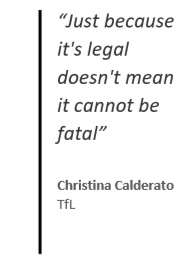
Transport for London has launched a new campaign to highlight the dangers drivers and motorcyclists pose when travelling at inappropriate speeds.
Launched on 8 May, ‘Risk Up’ warns drivers and riders that travelling too fast for the condition of the road increases the risk of injury to themselves and other road users.
The campaign carries two slogans: ‘Drivers. On built-up streets, when your foot goes down, the risks go up’, and ‘Motorcyclists. If you’re in a hurry, when you throttle up the risks go up’.

TfL says that in 2016, there were 804 collisions resulting in death or serious injury as a result of illegal and inappropriate speed in the Capital, with 329 of these involving a motorbike.
The new campaign reminds motorists of circumstances in which they can ‘inadvertently’ drive or ride at an inappropriate speed, including in built up areas and when going round corners.
TfL points to the Highway Code which recommends reducing speed when:
- Sharing the road with, for example, pedestrians or cyclists
- The road layout or condition presents hazards, such as bends
- Weather conditions make it safer to do so
- Driving at night, as it is more difficult to see other road users
Christina Calderato, head of delivery planning at TfL, said: “It is vital to change attitudes towards driving at speeds not suitable for the conditions of the road.
“Motorists who drink and drive are seen as behaving in a dangerous and selfish manner with little regard for the safety of other people.
“However, those who drive too fast are often not regarded in this way, unless they grossly exceed the speed limit.
“By clearly explaining the dangers, in the way that has been done for drink-driving, Risk Up aims to work towards a general acceptance and ownership of the problem of inappropriate speed. Just because it’s legal doesn’t mean it cannot be fatal.”
Funny that we often use the term ‘unable to stop in time’ yet all the published data about stopping is referenced in terms of distance. Maybe it’s our subconscious way of telling the various authorities that we need a time based reference rather than a distance based one. The fact that it takes roughly 1 second to loose 10 mph of speed is perhaps a much better way of relating stopping requirements to our real-world experiences.
This also brings about a better understanding of our ‘stop horizon’ so that we know that we are probably going to hit anything that appears between us and the horizon. It should also be noted that the stop horizon is never closer than three seconds down the road to allow for any perception/reaction lag.
Duncan MacKillop
0
What we see again here is a confused message about speed. It mixes up speed above the limit with “unable to stop in time” (credit Hugh) speed. “Unable to stop in time” speed is *always* bad, and that generally includes speed much above about 5mph where vulnerable road users are likely to be encountered. On the other hand, speed above the limit is (in my book) perfectly acceptable so long as it isn’t also “unable to stop in time” speed.
We must surely, at the very least, attempt to present a consistent message here if we are to be taken seriously, and as the overriding concern is, presumably, road safety, we must concentrate on evidence-based facts and consistency, and try to avoid conflating anything else (including illegality) with danger. The road safety message should be that an “unable to stop in time” speed is totally unacceptable, whether or not it is within the posted speed limit.
I would go as far as to say that because of the arbitrary nature of speed limits and the mixed and unsustainable message that they give, they reduce rather than improve road safety. And because of that, my view is that they should either be abolished, converted from mandatory to recommended, or – better still – replaced with “road environment type” signs to inform visiting drivers of any significant upcoming change of road use (to community streets, access roads, through roads, motor only roads, or whatever). If we are to have sustainably safe roads we are going to have to start allowing drivers to take complete responsibility for their own actions, and stop denying them that privilege which all other road user types enjoy. Remember, drivers too are human beings and need to be treated with respect and not contempt. That way we will likely see a step change reduction in road casualties, a reduction of congestion (largely caused by current “road safety” measures) and an inherently and sustainably safe road network.
Charles, England
--8
‘Inappropriate speed’ should perhaps be called ‘unable to stop in time’ speed or ‘not in full control’ speed. If it’s within the speed limit, it’s surely careless or dangerous driving and therefore not ‘legal’ anyway – if it’s above the limit then it’s not ‘legal’ several times over.
Hugh Jones
+7
There appears to be some contradiction in this campaign.
“Just because it’s legal” as a strap line yet including illegal speed casualty data to back up the campaign.
It’s possible this was a mistake it is also entirely possible that numbers were so low without including illegal speed data that they would fail to have an impact or justify the campaign.
That said the concept should be applauded as inapropriate speed is a far greater issue than excess speed which gets far greater recourse and publicity.
Chris Harrison, bristol
+11